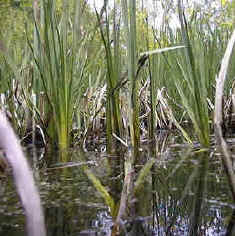Walking through a
Wetland ...
.
Dry Land |
>> | Marsh |
Swamp |
>> | Open Water |
|
Marsh to Swamp Further into the wetland, swamp plants such as Yellow Iris and Branched Bur-reed start to appear. These have tall sword-shaped leaves which rise out of the now deeper water. On a hot sunny day, jewel bright, blue and red adult damselflies may perch on the plants, while larger dragonflies acrobatically hunt the air above the wetlands. In both marsh and swamp areas, there will also be minute snails crawling over the plants, spiders trapping insects in their webs and grass snakes slithering silently through the undergrowth on the hunt for small frogs. Hoverflies and Bumble Bees fill the air with a heavy droning as they investigate the flowers of the plants for nectar. |
.. |
|
| As you walk through this swamp area of the
wetland, your feet sink deep into the accumulated layers of mud. The mud is held in place
by all the old dead leaves and stems of the plants which have died back the winter before.
It is dark and blackish and as you disturb it, the scent of rotten eggs wafts up! The lack of air in the mud (because any space is full of water, not air) means that the decomposition and recycling of dead plants and animals in the wetland has to be done by organisms which don't need air. A smelly gas, which is the same as that produced by rotting eggs, is one of the products of this decomposition. Another one is called Marsh Gas. This gas is very inflammable and small patches of it may sometimes spontaneously catch fire. In times past, these flickering tiny flames in marshes, visible at night, came to be known as Will 'o' the Wisps. People then, didn't know where they came from and thought they were produced by magic of some sort! Continuing on through the swamp, tall Reedmace plants, also known as Bulrushes, may tower over your head, with the fuzzy brown seed heads shedding their seeds into the wind. Water voles rustle in the reeds and deer come to drink and lie in the cool mud. Open pools of water start to appear here as the water becomes deeper still and the swamp plants begin to thin out. The pools are full of a staggering variety of life, from water beetles and bugs, to small fish such as sticklebacks. In the spring, frogs and toads in their thousands will come to mate and lay their eggs. |
|
